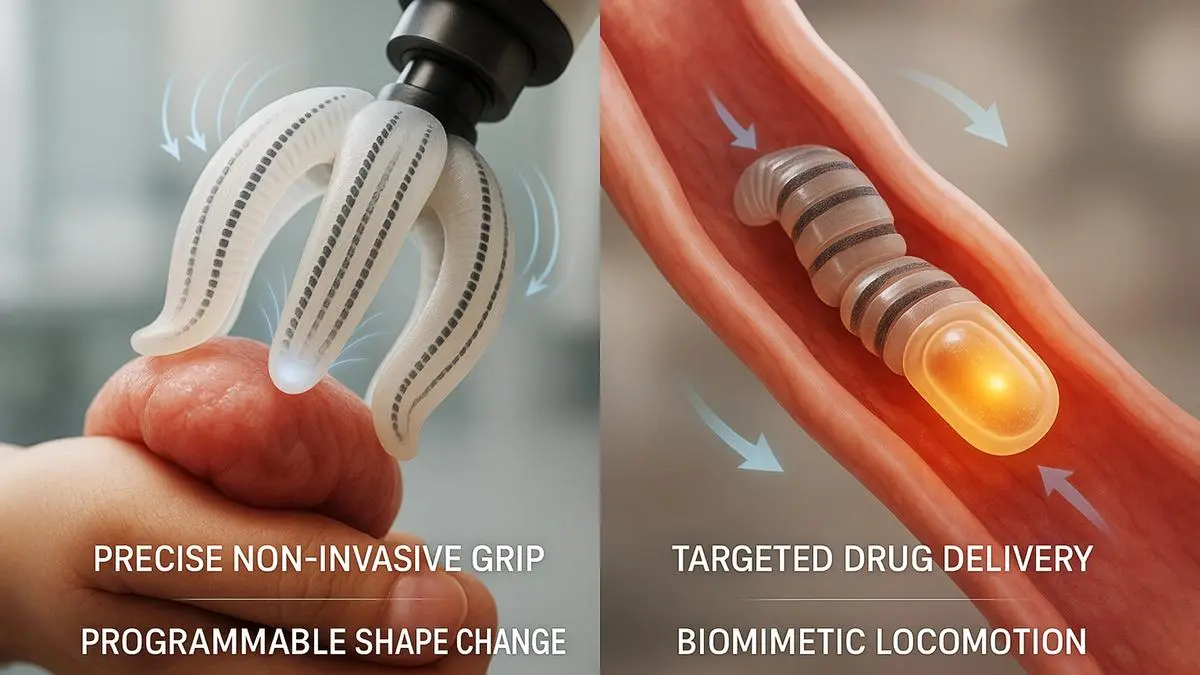BIO-INSPIRED BOTS: Magnetic soft actuators developed by IIT-Madras researchers
Imagine a medical tool that opens like a flower to gently lift tissue or a soft ribbon that curls and uncurls in a controlled, rhythmic motion, guided by forces you cannot see. These are not zany visions from science fiction, but real prototypes emerging from a lab at IIT-Madras.
A recent paper, titled Nature-inspired shape-shifting soft magnetic materials: Inspiration, fabrication, mechanism, and application, by Dharmi Chand and Sivakumar MS, unveiled a new class of soft, magnetically responsive materials that can bend, twist and grip, all without motors, wires or onboard electronics. This makes them promising for delicate applications like biomedical devices and minimally invasive tools.
Mimicking nature
The field of soft robotics draws heavily from nature. Creatures like jellyfish and sea slugs adapt their shape and motion in response to their environment. Engineers are replicating such abilities using smart materials that deform under light, heat, humidity or magnetic fields. Among these, magnetic actuation stands out for its speed, reversibility and precise control without physical contact.
The IIT-Madras team created magnetic soft actuators using flexible polymers embedded with magnetic particles.
Magnetic motion
Traditionally, soft robots have used hard magnetic particles, which retain their magnetisation. However, this also creates problems, such as hysteresis and non-linear response to changing fields.
The IIT-Madras team used soft magnetic particles that magnetise only when the field is active and return to a neutral state when removed. This results in repeatable, reversible shape changes, with cleaner control.
The fabrication of the soft magnetic actuator begins with infusing silicone-based actuators with carbonyl iron particles. These are moulded into specific shapes and exposed to magnetic fields to align the particles along the field lines. Under a microscope, the researchers observed how the particles formed long chains inside the material, storing the ability to bend when re-exposed to a magnetic field.
But instead of relying solely on this moulding process, the team devised a smarter method.
They replicated the internal magnetic structure by embedding the soft material with thin iron rods of high length-to-width ratios. These rods act like internal muscles, bending the polymer when exposed to a magnetic field. By carefully controlling the placement and angle, the team could programme complex, graceful formations without using electronics.
“Our advanced work in this direction — stamp-based printing — enables scalable fabrication of micron to submicron robots, while our UV-based shape programming advances the creation of complex, functional geometries. Together, these developments bring us closer to real-world deployment, where soft robots can be designed and manufactured efficiently, even outside high-tech labs,” says Chand.
The researchers built two demonstrator devices: a gripper and a crawler.
Flower-like gripper
Inspired by blooming flower petals, the gripper features six flexible arms. Iron rods were embedded within these arms in a layered fabrication process, sandwiching them in thermoplastic polyurethane (TPU). When placed in a magnetic field, the arms bend inward or outward, allowing the gripper to grasp and release objects of different shapes and materials, including a 3D-printed ball, a cylinder and soft clay.
Because magnetic fields can be adjusted externally, the grip strength and timing can be finely tuned. This makes the device ideal for tasks involving delicate manipulation, especially in constrained or sterile environments, such as surgery or laboratory automation.
Curling crawler
The second prototype is a soft strip that moves with a crawling motion when subjected to an oscillating magnetic field. Unlike the gripper, this device uses magnetic rods at both ends.
When the field changes rhythmically, the ends contract and release in a coordinated fashion, propelling the device forward at 2.5 mm per second.
What sets this crawler apart is its simplicity and programmability. The researchers achieved directional movement using just two embedded magnetic rods placed at strategic points, mimicking the contraction and extension cycles seen in biological motion. By tuning the placement of these rods, the team can modify how the crawler bends and in which direction it travels.
Looking ahead
“Soft robotics holds the key to a new generation of machines that are safe, adaptive and capable of navigating environments where traditional robots fail. From targeted drug delivery and minimally invasive surgery to environmental sensing, wearable devices and even space exploration, their applications are vast,” says Chand.
Moreover, the new fabrication approach offers a scalable alternative to complex moulding, potentially enabling the production of customised, application-specific soft robots. As the researchers point out, this is just the beginning. Future iterations could incorporate AI-guided actuation, real-time field control and miniaturisation to tackle ever more complex tasks.
More Like This
Published on August 11, 2025
